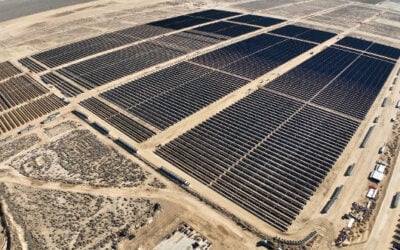Eos Energy Stack. Image: Eos Energy Storage.
Solar PV paired with energy storage at scale could be provided to utilities at just US$0.10 per kilowatt hour, using advanced battery technology, one manufacturer has claimed.
Philippe Bouchard, VP of business development at Eos Energy Storage, which makes its own novel zinc hybrid cathode batteries at grid-scale, told Energy-Storage.News that the company is increasingly interested in supplying solar-plus-storage solutions to utilities in the US.
Eos claims to have perfected a DC battery, available in 1MW/4MWh blocks as part of its Aurora grid-scale storage system, at just US$160 per kWh, which it says is 30% to 40% lower cost than a comparable lithium ion system. Eos’ battery, branded Znyth, can provide four hours of continuous discharge. At the end of last month Eos announced a manufacturing and assembly partnership with Environment One Corporation to make the company’s patented Energy Stack plug-and-play DC module in New York with a dedicated facility planned in mid-2017 and an expected output of 400MWh per year. Energy Stacks are aggregated together to form each Aurora system.
“The integration of renewables is obviously an acute need for many utilities. Some geographies, both in the US and internationally have such high penetrations of solar that within that specific region they don’t want or need any more solar,” Bouchard said.
Try Premium for just $1
- Full premium access for the first month at only $1
- Converts to an annual rate after 30 days unless cancelled
- Cancel anytime during the trial period
Premium Benefits
- Expert industry analysis and interviews
- Digital access to PV Tech Power journal
- Exclusive event discounts
Or get the full Premium subscription right away
Or continue reading this article for free
“In fact, you’ll have so much energy production coming online around noon or 1pm, when the solar assets are peaking, you’re pushing the locational marginal pricing negative so the independent system operators will pay off-takers to consume that electricity.”
Bouchard referred to regions of the US with high solar penetration such as California or Arizona where this is the case and that many utilities are anticipating introducing time of production tariffs. He said that by using a battery such as Eos’ at large-scale, utilities can help smooth out the variability of solar generation and meet their evening peak of demand, typically from 5pm to 9pm.
According to Bouchard, Eos is already in talks with a number of solar developers with an eye to developing projects during 2017. He said leveraging the synergies between the solar and storage elements of such projects could help lower costs and give utilities a renewable but dispatchable energy or capacity service.
“We’re looking at a combined asset, maybe a 90MW solar plant with a 50MW/200MWh battery so a fairly significant size, but the LCOE of that asset is already at today’s pricing below 10 cents per kWh, and riding our wave down the price curve with volume we believe we can get that below 8 cents per kWh,” Bouchard said.
A recent project by AES on the Hawaiian island of Kaua’i will deliver power to the local Kauaʻi Island Utility Cooperative (KIUC) at US$0.11 per kWh.





